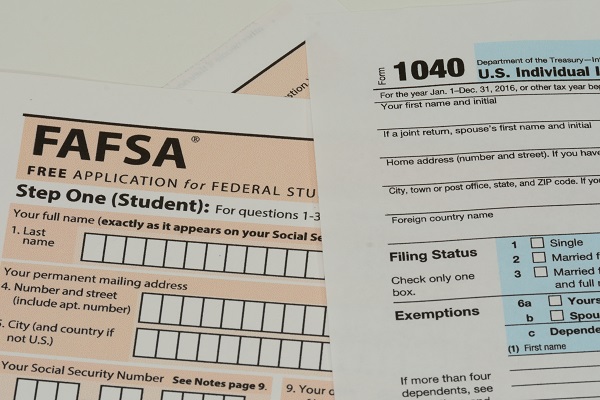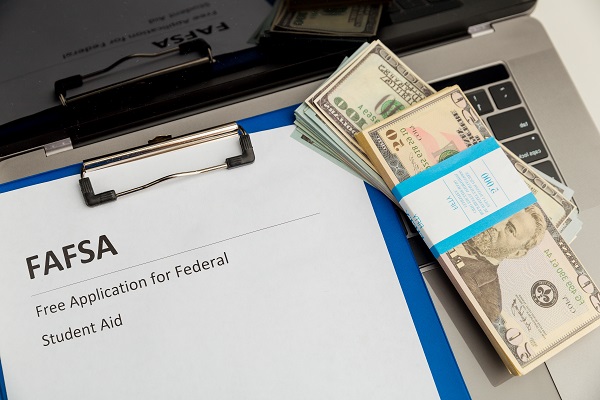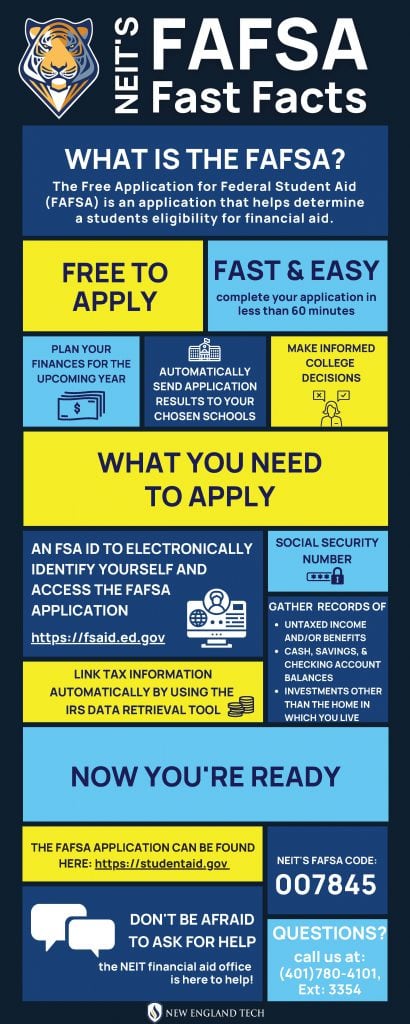One of the biggest concerns for students planning their higher education is the financial burden college creates. That’s why financial aid programs like FAFSA are so important for students. But, what is FAFSA, exactly?
The phrase stands for the ‘Free Application for Federal Student Aid’ and refers to a process which helps determine a student’s eligibility for receiving financial support.
Table of Contents
How Does the FAFSA Work?
The Department of Education’s Office of Federal Student Aid delivers the money to help pay for your schooling. Here’s how you can access those funds:
-
Earn your degree in as little as 18 months! Apply today!
Loading…
/**/
- You must fill out the FAFSA form along with your college code before you start college.
- Once you submit your FAFSA form within the federal deadline, you’ll receive a detailed student aid report (SAR) containing the list of federal student loans and Federal Pell Grant that you can receive. Colleges use the FAFSA data to determine a student’s federal aid eligibility.
- Consult the colleges’ financial aid offices you’re interested in to know the total amount you’ll receive. Compare the cost and aid offers, and select the best offer.
- After accepting an offer, the federal student aid department will send the money directly to your college. Your college financial aid office will deduct this amount and send you the remaining balance to spend on college costs.
- Once you graduate, you can start repaying the loan. Graduate students have a six-month grace period before they start repaying their loans.
Please note that you must fill out the FAFSA form every year and maintain satisfactory academic progress to receive federal financial aid.
To help you filter through all the information available online, we’ve put together a guide to answer the most common questions about FAFSA. If you’re curious about what FAFSA is and how it can help you, read on!
Free Application for Federal Student Aid (FAFSA) Details
WHY PAY FOR YOUR DEGREE ALL BY YOURSELF?
Earn your degree at NEIT with financial aid and begin your new career path today!
ASSOCIATE'S DEGREE
BACHELOR'S DEGREE
MASTER'S DEGREE
As a parent, you worry about paying for your child’s college education, irrespective of your financial situation, how much you earn, or how much you have saved up over the years.
Almost all universities and colleges have an in-house FAFSA department to determine students’ eligibility and how much aid they are likely to receive. This serves as the reference point for your aid package and expected family contribution.
The federal student aid asks you about your financial information, tax returns, and other essential things to determine your financial aid eligibility.
The Main Purpose of FAFSA & Eligibility
Once you submit your application form, the federal student aid office sends you a detailed report of the funds you’re eligible to receive. These funds are in need-based aid, loans, and scholarships. The federal student aid department directly transfers the amount to your college.
FAFSA is an initiative by The Department of Education to assist students in paying for their Remember, FAFSA isn’t necessarily a loan. Depending on your financial needs, the student aid department can give your grants, loans, and scholarships. Loans are of two types-direct unsubsidized loans and subsidized or ‘low-interest loans.’
Who is eligible? Every U.S. citizen with a social security number can apply for FAFSA subject to meeting the education requirement. Every applicant must have their high-school diploma/GED and submit their enrollment/acceptance letter in an eligible degree/certificate program.
Who Should Fill Out the FAFSA?
If you plan on going to college in the next academic year, it’s time to start filling out the FAFSA. As mentioned above, getting federal student aid is a great way to organize your finances and prepare to pay for your college education.
You can use the FAFSA to apply for federal grants, work-study programs, and loans. Colleges in most states also use your FAFSA information to award non-federal aid.
Listed below are a few reasons why applying for federal aid to pay for your school or college education is a good idea:
- Most federal work-study programs require the FAFSA.
- If you don’t apply, you won’t qualify.
- The FAFSA isn’t meant only for low-income groups.
- Even if you are financially well-equipped, you can be eligible for federal student aid.
- Most merit-based scholarships will require the FAFSA to determine your scholarship amount.
- Federal loans are easier and cheaper to pay compared to private student loans.
- After you submit the FAFSA, you qualify for low-interest federal loans.

Where Can I Access the FAFSA Form?
There are three ways you can go about applying for federal aid from the Department of Education for the next academic year:
- Head to fafsa.ed.gov and apply online.
- Use the myStudentAid mobile app (available for download on iTunes and Google Play).
- If filled out by hand, mail it to the address provided.
It is better to complete the FAFSA using method #1 or #2 since these options are easiest and most efficient. While filling out the form, you need to create a federal student aid I.D. or FSA ID for yourself. One parent must also generate this I.D.
Documents Required for Federal Financial Aid
The FAFSA will collect your (and your parents’) personal and financial data and deliver it to colleges where you have applied. You do not have to submit your parents’ details if you’re not dependent on them.
Your FSA ID (refer to the section above) will enable you to apply for this aid and serve as the formal (legal) signature, too. You can use the Federal School Code Search tool to find the federal school code for every college you want to apply to.

Here’s the complete list of documents you will need:
Personal Documents
- Your social security number
- Your parents’ social security numbers
- Your driver’s license number
- Your Alien Registration number (for non-U.S. citizens)
Financial Documents
- Federal tax information
- Records of untaxed income
- Other financial holdings
- Details of your savings accounts and investments
Head to the official FAFSA website to get more information about the documentation you need to complete the FAFSA formalities.
How to Fill Out the FAFSA Form
The official website is your one-stop-shop for all things FAFSA. Once you log in with your FSA ID, you will need to enter your details and answer a list of questions that determine your dependency status.
Next up, you need to furnish all the relevant details about your parents along with your financial data (income, assets, investments, tax forms, etc.) If you are applying this year, you should enter the financial information from the 2018 tax year. The website’s built-in IRS Data Retrieval Tool will help you automatically pull out the relevant data.
The next step is to list all the schools or colleges you wish to apply to as a student. You can enter up to 10 colleges and universities in this application.
The best way to ensure that the process goes smoothly is to keep all this information handy before starting your online application. You can also enter some details, save your progress online, and continue later.
Check out these handy tips for completing the FAFSA online.
FAFSA Deadline
The deadline for a student to submit their FAFSA is June 30 (midnight). However, certain states or colleges may have specific cutoff times and dates for financial aid applications. You can find more information about this on the Federal Student Aid deadlines website. Alternatively, you can get in touch with your financial aid office.
Ideally, you should submit the FAFSA as soon as it opens for filing on October 1. The Department of Education allows you to submit the form between October and June, but it is best to do so at the earliest.
Where Do You Submit the FAFSA Form?
There are three ways you can submit the form:
- Submit it online on the website using your FSA ID
- Ask your college to submit FAFSA directly on your behalf.
- Take a printout of the PDF version of the form. Fill it out and mail the copy to Federal Student Aid Programs, P.O. Box 7650, London, KY 40742-7650.
Types of Aid Offered Through the FAFSA
The FAFSA offers various financial aid packages to students applying for a college education in the forthcoming academic year. Here’s a quick look at all of them:
Federal grants
Grants refer to non-repayable money. Federal grants for college education are per the students’ needs and depend on your FAFSA results.
Scholarships

Your school may offer you a scholarship, which refers to money you will never need to pay back. In most cases, you earn a scholarship on merit. If you have done exceedingly well in academics, athletics, or other fields, you could be eligible for a scholarship from your school.
A scholarship might require you to maintain stellar academic progress to keep receiving the aid in some cases.
Work-Study Loans
Your federal student loan could include work-study provisions, which means you can earn and pay back this money by working part-time on campus. Get in touch with your financial aid office for further information about these programs and the related repayment options.
Federal Student Loans
The federal government offers a wide range of federal direct subsidized loans and unsubsidized student loan options that help students pay for college. With a student loan, you are liable to pay the money back to the federal government with interest.
Wondering how to get financial aid or which kind of aid package is most suitable for you? Head to our Financial Aid Overview page for help.
How is Financial Aid Calculated?
Okay, so you need financial aid to pay for college. But how will the authorities determine how much money you are eligible to receive as aid? It depends on these four factors:
- Your year in school
- Your enrollment status (part-time or full-time)
- Cost of attendance (COA)
- Expected family contribution (EFC)

COA refers to the actual cost you would incur for going to a particular college for one year. This cost includes your tuition, study material, supplies, boarding, and other expenses. The COA may differ from school to school.
EFC is the amount of money that the federal government anticipates your family can afford for one year. The FAFSA assumes that 20% of your assets and 5.64% of your parent’s assets are available for spending in a year.
Since your Student Aid Report (SAR) lists the EFC, ensure all the information you entered in your FAFSA reflects correctly on the SAR.
For financial aid calculation, subtract the EFC from the COA. This total is roughly the amount that you will need in the form of aid. As mentioned above, since the cost of attendance varies from college to college, every college will individually calculate and determine the aid amount.
Need Vs. Non-need Based Financial Aid
Federal Pell Grants, Supplemental Education Opportunity Grants, Work-Study Programs, and Direct Subsidized loans are examples of need-based grants. Students with exceptional financial needs receive grants, while most students are eligible for subsidized loans. Other students and parents can apply for unsubsidized loans, PLUS loans, and TEACH grants.
The primary difference between subsidized and unsubsidized loans is the amount of interest. When you take a subsidized loan, you do not have to pay interest for the duration you’re in school and six months afterward. Unsubsidized loans accrue interest from day one.
What to Do If Your Family’s Financial Situation Has Changed?
Due to the recent COVID-19 pandemic or any other reason, if your family’s financial situation has changed, you can apply for FAFSA form readjustment. You must complete the FAFSA questions and submit the form. Discuss with your school’s financial aid office regarding the revised amount. They can readjust the amount as per your current family income.
How Long Does It Take to Get the FAFSA Money?
You must complete the FAFSA well before the June deadline, get your SAR, notify the colleges that you want to get financial aid, and complete any additional requirements that they may have. Once you have successfully gone through this entire cycle, your schools will send you a financial aid award letter along with (or after) the acceptance letter.
The time between your application submission and the receipt of your financial aid award letter may range from a few weeks to a few months. Once you get the letter, you must accept or deny the aid before the deadline.
How Has the Coronavirus Pandemic Affected the FAFSA?
The relief measures included a suspension of loan repayments, a 0% interest rate throughout the period, and no collections on defaulted loans until the said period.
If you need any help filling out the form, visit the official FAFSA site for assistance or call 1-800-433-3243. You can also submit your queries through email or webchat.
Conclusion
FAFSA is an excellent initiative that helps students fund their college education. However, you must enroll at an eligible institution in an accredited program. The support you receive from your school is crucial in ensuring a hassle-free process.
The New England Institute of Technology provides financial aid for its certificate and degree programs. Learn how we can help you achieve your career goals.
WHY PAY FOR YOUR DEGREE ALL BY YOURSELF?
Earn your degree at NEIT with financial aid and begin your new career path today!
ASSOCIATE'S DEGREE
BACHELOR'S DEGREE
MASTER'S DEGREE
FAQs
How long does the FAFSA take?
The FAFSA process can take anywhere from a couple of weeks to a few months, depending on how soon you complete all the requirements and how much time it takes for the financial aid letter to reach you.
Who Qualifies for FAFSA?
To qualify for FAFSA, you need to:
- Be a U.S. citizen, or an eligible non-citizen (A permanent resident or a U.S. national)
- Have a social security number
- Have a high school diploma or GED certificate
- Be enrolled/accepted in an eligible degree/certificate program
Does FAFSA check your bank accounts?
Since it’s a form, FAFSA doesn’t check your bank account. But it requires you to complete a set of information regarding your assets, including checking and savings accounts. If your FAFSA is under verification, you might have to present the documents as proof that the amounts you entered were accurate.
Can the FAFSA cover full tuition?
No, you will not be able to cover all your school or college tuition costs with the FAFSA. It is a financial aid instrument designed to help you cover some or a significant portion of your college education expenses.


